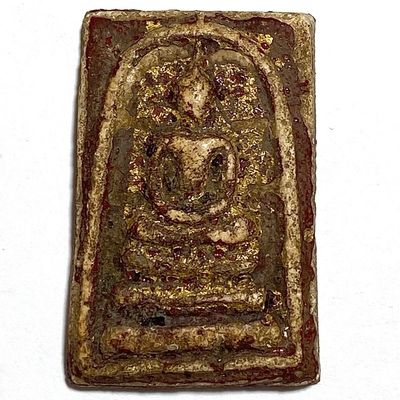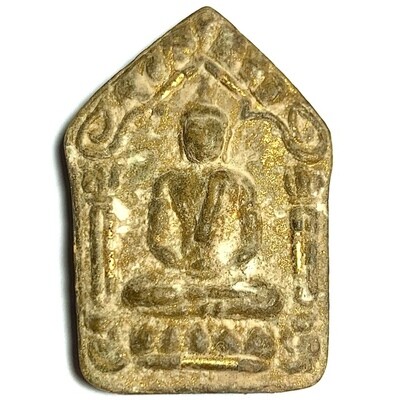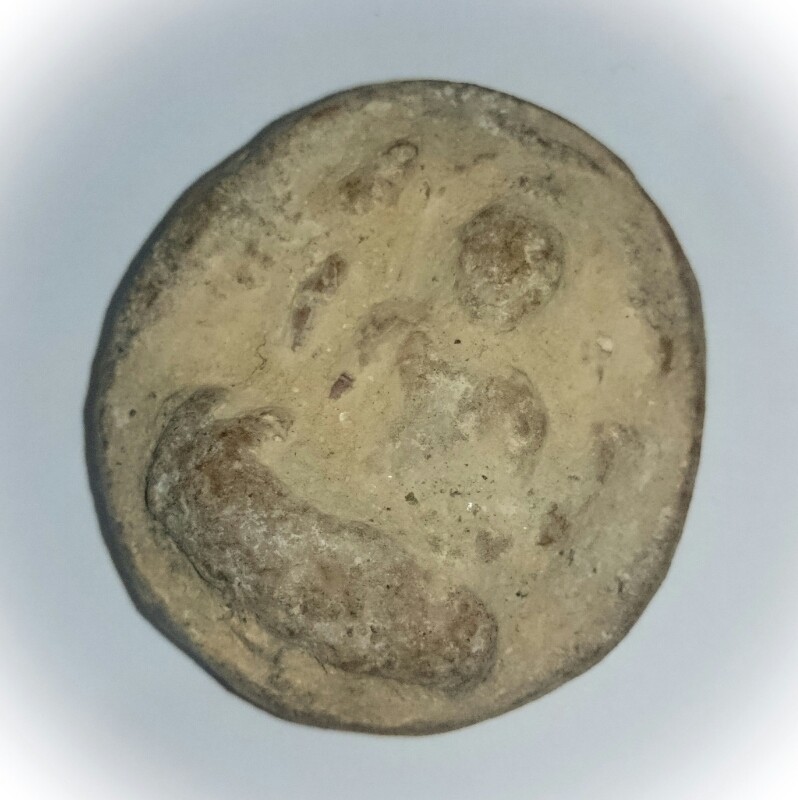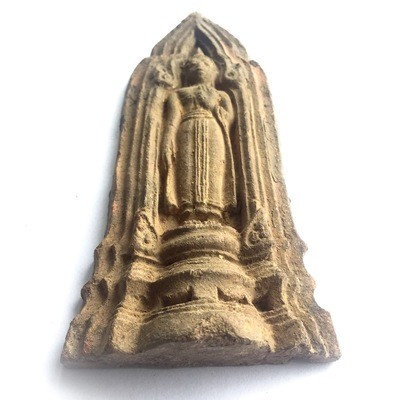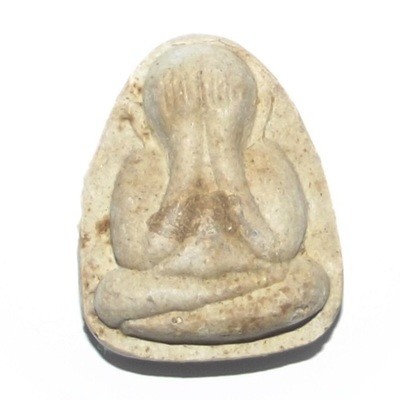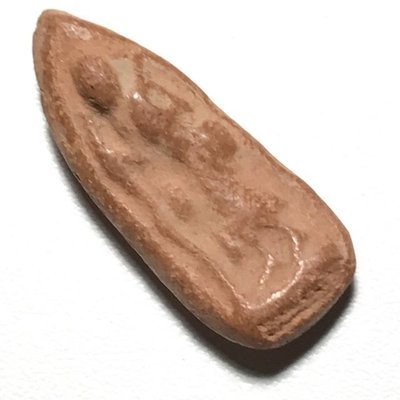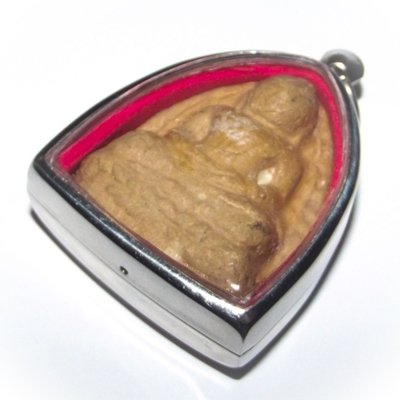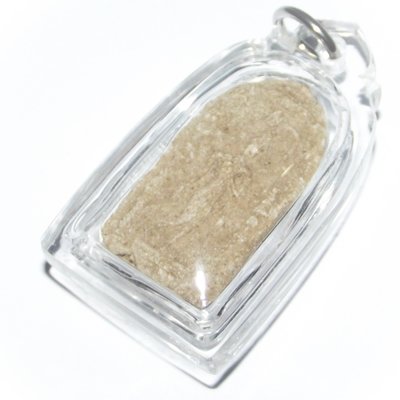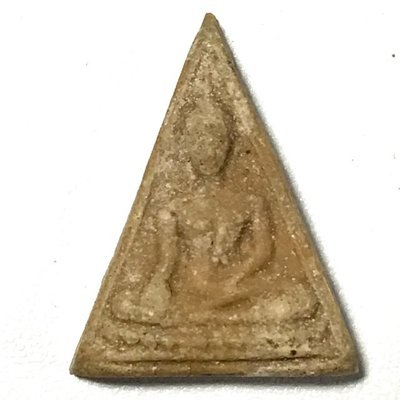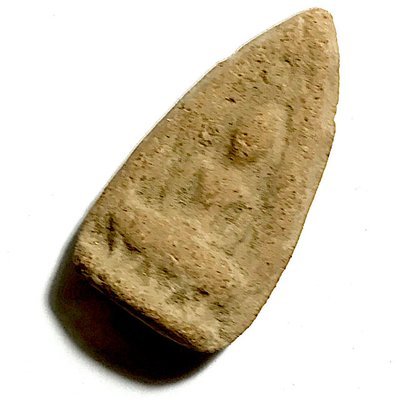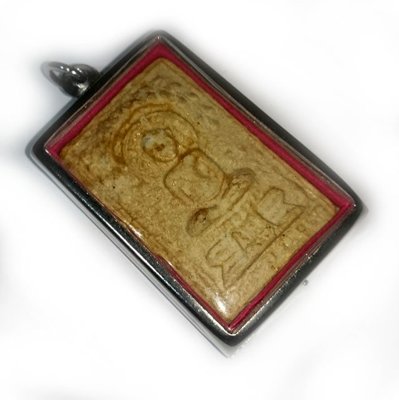Presenting a tiny but powerful and rare classic amulet from one of the Great Khao Or Masters of the 20th Century, Rian Glom Lek Hlang Chedi 2505 BE Nuea Tong Daeng Miniature Guru Monk Coin Por Tan Klai Wajasit
This Sacred amulet of the Great Khao Or Master of Nakorn Sri Tammarat, Master of Wat San Khan and Wat Pratat Noi, is a very rare amulet from Por Tan Klai’s 2505 BE Blessing Ceremony Edition, and is considered a ‘Jaek mae Krua’ type amulet (meaning ‘give to the kitchen maids and temple helpers’), which is suitable not only for men, but due to its miniature size, a perfect amulet for ladies or children to wear.

Rian Glom Lek 2505 BE Por Tan Klai Wajasit Wat Suan Khan
The 2505 BE edition of amulets of Por Tan Klai, is a highly preferred edition, which saw his famous ‘Rian Glom’ round Monk coin amulet with Chakra released, The Rian Glom Lek Hlang Chedi, and the Roop Tai Por Tan Klai Guru Monk Blesséd Photographamulets such as look om chan hmak and ya sen tobacco balls, and sacred powder amulets of various models.
A very rare and highly prized amulet for the devotees of Por Tan Klai to associate with his image and pray to him with a blessed image of the Guru, and the Chedi Relic Stupa on rear face for Buddhanussati and Marananussati. A powerful and Sacred amulet which has passed through the hands of the Guru and been blessed by him.
Por Tan Klai was one of the Top Guru Master Monks of the Last Century, and is considered one of the Four Great Masters of the Previous Generation of Lineage Masters of the Khao Or Southern Sorcery Lineage.
Kata Bucha Por Tan Klai
Pra Pim Pra Bodhisattva Avalokiteshvara (4 Armed) 1200 year old Ancient Amulet from the Sri Vichai Period (Museum Piece) - Nakorn Sri Tammarat Archeological Dig
Extremely Ancient and Sacred 1200 Year Old Buddist Sacred Artifact Votive Tablet from the early Sri Vichai Mahayana Period, created during the Advent of Buddhism, Found in an Archeological Dig at Nakorn Sri Tammarat in South Thailand.
The only other example of this amulet we have found in existence that is available for the Public Eye, is a Pristine example which has been lovingly and carefully restored by Experts from the Archeology department and Installed at the Museum of the University and Ministry of Ancient Buddhist Arts of Thailand, in the Archeology Section of the Department of South-East Asian Studies.
This exhibit is half as old as Buddhism itself, and is truly worthy of the title of 'Ancient Amulet'.

The clay is made from 'Nuea Din' earthen clays as was ubiquitous in the Sri Vichai Era of Silapa Nakorn Southern Thai Amulets, Statues and Molded Images, and is very dense and hard, as can be expected from such an immensely ancient amulet, which has been lost and buried under the ground for at least a thousand years.

The rear face has some figures barely visible, which are a scene depiction, but which we are yet unable to decipher. The edges of the votive tablet have indentation as has been seen to be common in various archeologial dig finds of Ancient Amulets of the Sri Vichai Period, and which are most commonly noticeable in the famous 2525 BE discovery of the Pra Kru Met Gradum Sri Vichai Archeological Dig Find, from Khao Sri Vichai Mountain district of Surat Thani.

For True Buddhists, this is of course one of the most highly Sacred Votive Tablets one could Possess, and for Mahayana and Vajrayana Buddhists, even more so, being a depiction of the Mahayana Bhodisattva Avalokiteshvara ('Chenrezig' in Tibetan).


The rear right arm (to our left) carries a Stupa, which is typically common in Ancient Mahayana Buddhist depictions of the Avalokiteshvara Bodhisattva in Indian Paava Periodic Art (Sri Vichai). It was at this period of Thai Buddhism, that Indian and Sri Langkan Buddhists travelled over the Indian Ocean and Andaman Sea to bring Buddhism to South Thailand, and this is the reason why the Sri Vichai and the Silapa Nakorn Southern Buddhist arts of this period are so highly influenced by the Indian Artistic Impression. Most of the Images were made by the Indian Vedic Peoples who had come to inhabit the Southern Territories of the Sri Vichai Kingdom, long before it became Siam.
Below; The same image from the same archeological dig (Priceless restoration piece) in Nakorn Sri Tammarat -(See; http://www.archae.su.ac.th/art_in_south/index.php/map/catagories/nakornsrithammarat/item/46-museum-nakorn-a06.html)

if you examine very closely, you will see the bricks to the side of the right of the Bodhisattva (our left) and will also find them evident in both above and below exhibits - the Stupa in the Bodhisattvas rear right hand, and the curved arm and torso of the Bodhisattva are also notably similar, confirming the same origins from the same dig. The front pair of arms are in the meditative position with the front right hand resting on the knee and the front left hand in the lap. The Bodhisattva's left arm (on our right), has an elegant curve, both exhibits possessing the same posture. The oval line around the head representing an Aura is also visibly the same design. The below image is enhanced with some thin white lines drawn on the contours of the features to indicate the similarities. One can also notice the V shaped collar jewelry on both images.

This is a most sacred item and can only serve to empowere one's faith and Buddhanussati (remembrance of the Buddha and the Enlightened Ones) and can be considered a true Buddhist Relic for Prayer and reverence, and bestowal of Buddhist BVlessings, and the Powerful protection of the Bodhisattva Avalokiteshvara. Imbued with the authentic ancient Buddha Abhiseka Blessings of the Ancient Masters, from a time when the most powerful ceremonies by the most authentic Monks of Ancient Times will have been present to empower the votive tablets.

Having said that, we must stress that this item is also above all a most eminent and serious Museum Piece, which is to be highly respected and cared for. To own this amulet one should realise that it should not be used oir taken frivolously, and that it should be respected and kept for Preservation. It is only for truly Devoted Buddhists of High Faith, and those who are devoted to Preservation of Ancient sacred Arts, and Historical Artifact Collection.
This Votive Tablet is most certainly a Priceless Artifact, that is Suitable for Official Museum Exhibition.

Free casing be it in custom silver or gold is available included in the price if you do wish to keep it as a personal Votive Tablet for Bucha and Prayer, which is of course what it was originally intended for when it was created over a thousand years ago, but we feel that the amulet is also extremely valuable and attractive as a free standing museum exhibit, and can be appreciated at best without any casing to obscure it from clear inspection. hence, you should seriously consider the options according to how you intend to keep and use this Sacred Ancient Amulet.
The truth is, that we do not feel that it is easy to place this exhibit for release to the General Public, but we decided that it is important to allow it to be placed available, for it may find its way to a fitting residence worthy of its eminence. The price commands seriosity, and that it will only fall into the hands of a true collector and preserver of such Ancient Artifacts. It is fitting for this Exhibit to carry its prohibitive price in order to ensure that it can only be available to serious individual collectors and personal museums, or public museums through their preservation and acquisition funds.
May whoever owns this Votive Tablet please give it its due respect and install it in a fitting place of preservation, such as a glass showcase within your personal museum, or in the research facility of your institution.
We would like to thank the Thailand Department of Archeology Buddhist Aart of South Thailand Section Tammasat university South east Asian Studies for their great work in documenting this particular line of inquiry, and Providing the Public with a base of study for such rare and difficult to research works of Ancient Art.
